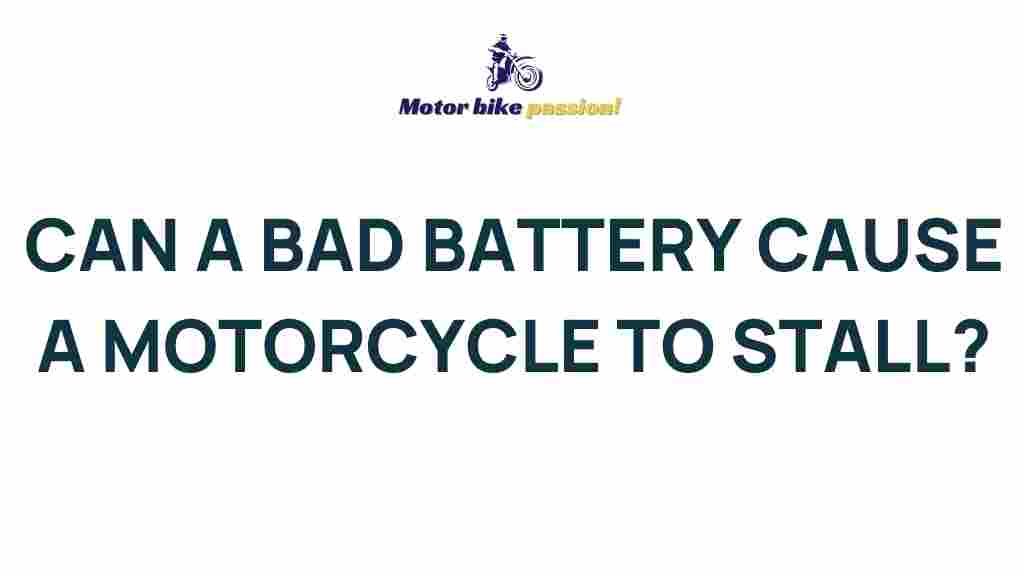Unveiling the Mystery: How Can a Faulty Battery Lead to Motorcycle Stalling?
If you’re an avid motorcycle enthusiast, you know the thrill of the open road, the roar of the engine, and the feeling of freedom that comes with riding. However, nothing can ruin your ride faster than a motorcycle stalling unexpectedly. One of the most common culprits behind this frustrating issue is a faulty battery. In this article, we will delve into the intricate relationship between your motorcycle’s battery and the stalling of its engine, providing you with troubleshooting and maintenance tips to keep your ride smooth and enjoyable.
Understanding the Role of the Battery in Your Motorcycle
The motorcycle battery is a critical component of the electrical system, serving several essential functions:
- Starting the Engine: The battery provides the necessary power to start the motorcycle engine. Without it, the engine won’t turn over.
- Powering Electrical Components: It powers the lights, indicators, and other electrical accessories when the engine is off.
- Regulating Voltage: It helps stabilize the voltage in the electrical system, ensuring that components receive the correct power supply.
When the battery is faulty, these functions can be compromised, leading to performance issues such as stalling.
How a Faulty Battery Causes Stalling
Stalling can occur for various reasons, but a faulty battery is often a primary suspect. Here’s how it happens:
- Insufficient Power: A weak or dying battery may not provide enough power to the starter motor, leading to failed starts or stalling after the engine has started.
- Voltage Fluctuations: A battery that cannot maintain a steady voltage can cause the engine’s electronic control unit (ECU) to misfire, resulting in stalling.
- Electrical System Failures: If the battery is not functioning correctly, it can affect the entire electrical system, leading to issues with sensors, lights, and ignition systems, which can cause stalling.
Signs of a Faulty Motorcycle Battery
Recognizing the signs of a failing battery can help you address issues before they lead to stalling:
- Slow Engine Crank: If the engine cranks slowly when starting, it may indicate a weak battery.
- Corrosion: Check for corrosion on battery terminals, which can disrupt the electrical connection.
- Dim Lights: Dimming headlights or indicators while the motorcycle is running can be a sign of battery issues.
- Frequent Stalling: If your motorcycle stalls often, especially after starting, the battery may be at fault.
Step-by-Step Troubleshooting for Battery-Related Stalling
To determine if a faulty battery is causing your motorcycle to stall, follow these troubleshooting steps:
Step 1: Check the Battery Connections
Begin by inspecting the battery terminals for tightness and cleanliness:
- Ensure that the positive (+) and negative (-) terminals are securely connected.
- Clean any corrosion with a mixture of baking soda and water, and ensure that connections are tight.
Step 2: Test the Battery Voltage
Using a multimeter, you can check the battery voltage:
- A fully charged battery should read around 12.6 volts or higher.
- If the reading is below 12.4 volts, the battery may be weak and require charging or replacement.
Step 3: Inspect for Physical Damage
Look for any physical signs of damage to the battery:
- Check for cracks, leaks, or swelling in the battery case.
- If you notice any damage, it’s essential to replace the battery.
Step 4: Load Test the Battery
If the battery passes the voltage test but still causes issues, perform a load test:
- Use a battery load tester to apply a load and see how the battery performs.
- If the voltage drops significantly under load, the battery is likely faulty.
Step 5: Check the Charging System
If the battery seems fine, the issue might be with the motorcycle’s charging system:
- Start the engine and check the voltage across the battery terminals; it should read between 13.5 to 14.5 volts when the engine is running.
- If the voltage is lower, your charging system may be faulty, affecting the battery’s ability to maintain a charge.
Battery Maintenance Tips
Regular maintenance can prolong the life of your motorcycle battery and prevent stalling:
- Regularly Clean Terminals: Keep battery terminals clean and free from corrosion.
- Check Fluid Levels: If your battery is not maintenance-free, check the electrolyte levels regularly and top up with distilled water as needed.
- Avoid Overcharging: Use a smart charger to avoid overcharging, which can damage the battery.
- Inspect Annually: Have your battery inspected as part of your motorcycle’s annual maintenance routine.
When to Replace Your Motorcycle Battery
Batteries do not last forever, and there are signs that indicate it’s time for a replacement:
- Age of the Battery: If your battery is more than three to five years old, consider replacing it as a precaution.
- Repeated Issues: If you frequently experience stalling or starting issues despite troubleshooting, it may be time for a new battery.
- Visible Damage: Any signs of physical damage or leaks warrant an immediate replacement.
Conclusion
A faulty battery can be a significant contributor to motorcycle stalling, affecting both performance and safety. By understanding the role of the battery in your motorcycle’s electrical system and recognizing the signs of a failing battery, you can troubleshoot and address issues before they lead to frustrating stalls on the road.
Regular maintenance, timely replacements, and proper troubleshooting techniques are essential to ensure your motorcycle runs smoothly. If you want to learn more about motorcycle maintenance or need help with your electrical system, check out our comprehensive guide on motorcycle maintenance tips.
Remember, a well-maintained motorcycle is a reliable one, and keeping your battery in top condition is crucial for enjoying your rides without interruption!
This article is in the category Maintenance Tips and created by MotorBikePassion Team

1 thought on “Unveiling the Mystery: How Can a Faulty Battery Lead to Motorcycle Stalling?”